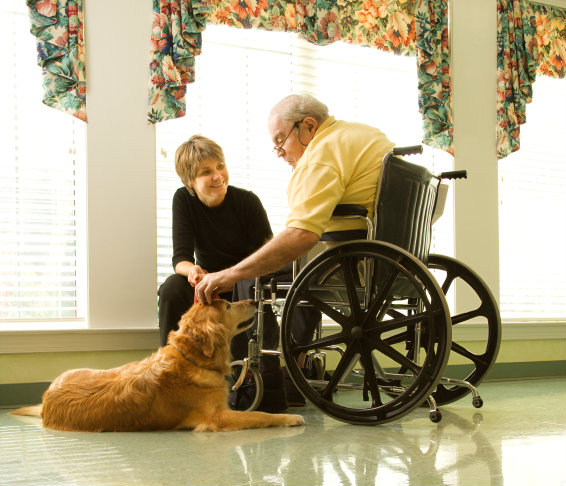Animal Assisted Therapy: How Your Dog Can Help With Physical Therapy
Posted on August 11, 2014 by joyofliving No comments

If you’ve suffered injuries from an accident or illness that required a long recovery including physical therapy, you know it can be hard to stick with it over time. With Animal Assisted Therapy (AAT), dogs can help add some variety and even fun to physical therapy sessions.
Physical therapists note when patients do their exercises while interacting with dogs, they tried harder, were more diligent and motivated to attend sessions. The AAT sessions offer many benefits including: increasing patient’s balance, mobility, endurance, range of motion and flexibility.
An article in the July 2014 Whole Dog Journal traced the journey of trainer Debi Davis and her dog Peek, as Peek worked with a variety of patients in AAT sessions. Here are some of Peek’s AAT experiences:
- A recovering stroke victim needed to go exercises to improve gross and fine motor skills. One exercise, squeezing a ball for the prescribed amount of time, was made more fun when Peek held the ball until the patient gripped it, squeezed the ball as directed, then threw it for Peek to retrieve and return. Resistance exercise was done by playing tug and release with Peek. He held the toy for the prescribed amount of time, then was cued to release the toy. To restore the patient’s hand strength, she would put clothing on Peek that had buttons, snaps and zippers, then unfasten the closures.
- Another patient with a head injury had to relearn using his arms and legs. Before the accident, the patient had loved throwing horseshoes, so Peek helped by gathering the ring’s and returning them to the patient to be thrown again. The patient stepped up his pace because he enjoyed watching Peek jump to retrieve the rings and return them. Balance and stretching exercises were also part of this patient’s recovery. Peek helped here by standing at predetermined position points, and the patient would stretch trying to reach Peek’s back to pet him. Peek would move to different points as directed so the patient would reach and stretch to each side and in front of his chair.
- A third patient was learning to walk again, graduating from wheelchair to walker. He held Peek’s leash, take a couple of steps and stop. Peek adjusted his pace to that of the patient. Having a walking buddy helped the patient enjoy the therapy more.
Qualities of a good AAT dog include: Comfortable interacting with a variety of people, friendly, sociable, and be calm and focused in crowded areas. If you’d like more information on AAT, go to petpartners.org

Comments